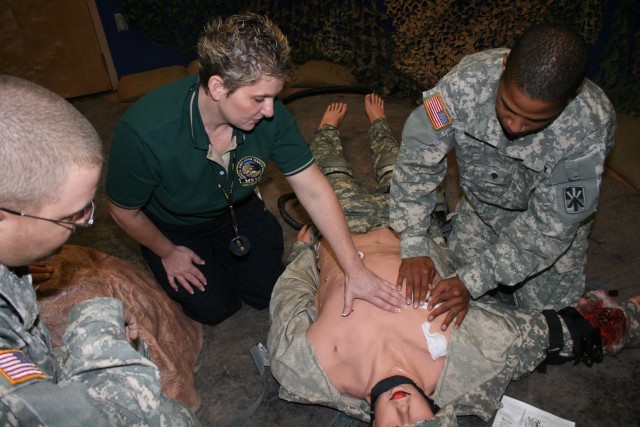The Fort Bliss Medical Simulation Training Center held an open house to mark its official opening, July 19. Four human patient simulators took center stage at the event. These simulators are the most innovative training tools Soldiers will use to train on combat lifesaver skills, said Joe Ricondo, Jr., Military Education and Government Systems and Programs.
The simulators are physiologically driven. What this means, said Ricondo, is they breathe, they live and die like any human being.
"[Dying] is dependent on the Soldier's intervention-what he or she does or doesn't do to the simulator," Ricondo said.
These computerized human replicas allow Soldiers to practice combat lifesaver skills within various scenarios under simulated battlefield conditions.
"One example is the below-the-knee traumatic amputation," Ricondo said. "It'll get the Soldier to see what an arterial bleed looks like and see what happens when they don't treat accordingly, and how physiologically [the simulator] will change."
Staff Sgt. Catherine Hannah, B Battery, 3rd Battalion, 6th Air Defense Artillery Brigade, was tasked with assessing a wound consisting of a severed leg. She applied a tourniquet to stop the bleeding. She said treating mock injuries on human simulators is the most practical way to prepare Soldiers for medical care on the battlefield.
"The dummy bleeds," said Hannah. "It's very realistic Ac"a,! dark, red gooey blood. When you put the tourniquet on, you check to make sure the bleeding stops and you drive on with your mission."
The Soldier will watch the simulator deteriorate or crash, if they fail to apply proper lifesaving techniques, Ricondo said. But more importantly, the Soldier can see what happens when there is a positive intervention.
"When the Soldier puts a tourniquet on the simulator and sees the stoppage of [blood] flow, they can see how much it takes to tighten down a tourniquet [properly]," said Ricondo.
The Soldier's interventions are monitored and recorded in the master patient monitoring station. Soldiers engaged in the training with the simulators do not interact with the trainers. The Soldiers have been taught everything they need to know up to this point. Kevin Williams, site manager, Fort Bliss MSTC said once the Soldier learns all the skills that are needed to help save lives, he or she is tested on their abilities.
"We're sitting in a control room watching, facilitating and doing an observer-controller type methodology of training," said Ricondo. "We're not going to lead them or hold their hand through the training. We're actually validating at this point."
Sgt. Robert Ornelas, B Btry., 1-56 ADA Bde., was evaluated on his ability to perform a chest decompression by inserting a catheter needle in the simulator's chest. Ornelas said he felt he was in the middle of a combat zone. I had to take care of this simulated patient and remain calm despite all the noise and commotion, said Ornelas. He said he was successful in his treatment. "The simulator lived!"
The center has four different validating rooms, Williams said. Software is hooked up to each human simulator, replicating breathing, bleeding and even speaking. The lights are dimmed, smoke is generated, combat sounds and strobe lights are added to the confusion.
"The train as you fight mentality is crucial here," said Ricondo. "We want to set the scene exactly how they're going to experience it in Iraq, Afghanistan and elsewhere. Our physiologically driven model is set up for that purpose."
Every intervention done by the Soldier is logged, to include the administering of drugs. The simulator will react accordingly, said Williams. If the Soldier takes a long time treating the simulator, it will die just like a real person will die.
"Right, wrong or indifferent we let the Soldiers do what they're suppose to do," said Ricondo. "If they make a bad choice we need to let them see the result of that bad choice."
In the event where the simulator dies or crashes, said Williams, the Soldier will be re-trained to improve their lifesaving skills and be re-evaluated.
Ricondo, who is a Somalia combat veteran, said lessons learned show that typically, the combat arms Soldier is the first respondent.
"He's the one who's clearing a house or going through a village," said Ricondo. "Whoever is there at the point of injury is the first respondent."
"There are critical things a combat lifesaver trained Soldier can do that will keep a wounded Soldier alive."
Soldiers who worked with the human simulators feel they are learning critical skills that will increase survivability on the battlefield.




Social Sharing